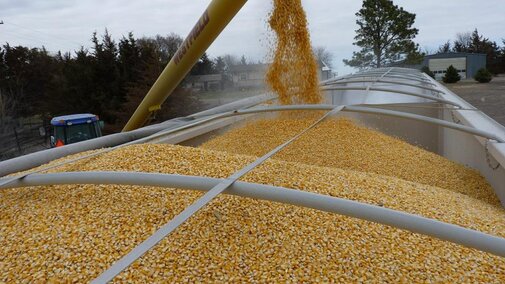The goal for any farmer holding grain in storage should be to obtain a better price for that crop in the spring or summer than the price offered at harvest.
Some farmers put grain in the bin looking to sell it by hitting a grain marketing “home run,” i.e., selling all of their grain in storage at the highest price possible. This one-shot marketing approach is rarely a successful strategy because farmers either sell grain before the market high hits or wait too long and end up with a lower price than what was offered at harvest. Savvy grain marketers tend not to use this one-shot approach. The most successful marketers write a grain-marketing plan that guides them to sell smaller quantities of grain throughout the year. This approach allows the farmer to be more in control of the final farm average price. The following five steps describe how to write a grain-marketing plan.
1. Break the total amount of grain into smaller units.
Instead of thinking of your marketing plan as selling all of your grain at once, sell your grain in smaller quantities. Most farmers think in 1,000- or 5,000-bushel quantities. This allows multiple sales to occur and therefore the opportunity to take part in unforeseen rallies (and further price declines).
2. Set price targets.
When determining price targets after harvest, you will want to set targets above the price you could have obtained at harvest, plus any additional expenses accrued by storage. The longer the grain remains in storage, the higher the price target will need to be. Expenses to consider are bin rental/maintenance/repairs, insurance on grain in storage, potential quality deterioration, and additional interest expense on operating notes.
It is important that you set realistic price targets. Setting prices too high or too low may be detrimental to your plan. When your price targets aren’t realistic, you either sell too quickly at a low price or hold grain too long, waiting for a price the market never reaches. Price targets can always be adjusted if market fundamentals change.
3. Set sales deadlines.
If prices do not rise enough to meet your price target, you need to set sales deadlines to ensure you are proactive about selling. Sales deadlines ensure that you aren’t continuing to incur storage expenses while prices decline. Target prices and sales deadlines work together to help you achieve a farm price in a range that helps you survive.
Commodity prices typically have a defined seasonal price pattern. Setting sales deadlines that correspond to periods when prices are traditionally highest will help make marketing easier. Price patterns vary by commodity. Corn prices are typically highest in the spring (March – June,) and soybean prices are traditionally highest in summer (June – July). Don’t forget to calculate storage costs when taking this approach.
Another consideration when selecting sales deadlines is your cash flow needs. Are there certain times of the year when you need to make sales to make payments? Plan and have this cash ready by setting sales deadlines ahead of payment dates.
4. Know your contracts
There are several types of contracts you can use to sell grain. You should work with your local elevator or broker to determine what marketing contracts are available to you and what contracts you should be using to achieve your price targets and sales deadlines. Typical marketing contracts offered by most local elevators are
- cash sales,
- forward cash contracts,
- basis contracts, and
- hedge to arrive (HTA) contracts.
You can also work with a broker to establish hedges, and/or an options position.
5. Share your plan with someone else
Once you have written your plan, share it with someone else. Sharing your goals with your spouse, merchandiser, or banker will help keep you accountable to your marketing goals.
Marketing plans can become more complex. However, this basic outline will help you get started. Remember, the goal of the marketing plan is not to get distracted from your goals determined at the beginning of the crop cycle.

